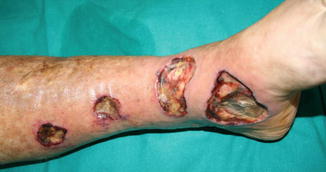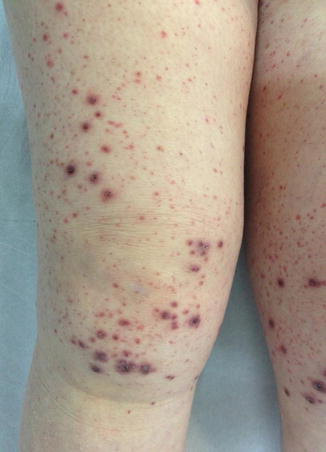Ischemic necrosis (40 % in type I, 0–20 % in mixed types)
Palpable purpura (15 % in type I, 80 % in mixed types)
Livedoid vasculitis (1 % in type I, 14 % in type III)
Cold-induced urticaria (15 % in type I, 10 % in type III)
Hyperkeratotic spicules in areas exposed to cold
Scarring of the tip of the nose, pinnae, fingertips, and toes
Acrocyanosis
Nail-fold capillary abnormalities

Fig. 28.1
Multiple punched-out ulcers, extremely painful, on the lower leg. Necrotic tissue and adherent fibrin on the wound bed in the absence of arterial disease

Fig. 28.2
Palpable purpura with hemorrhagic crusts
Biology: Presence or absence of disorders related to underlying conditions.
Histology: In cryoglobulinemia type I, it is evident that there is the presence of an eosinophilic pink coagulum filling dermal venules. In mixed cryoglobulinemia, there are the classical aspects of leukocytoclastic vasculitis (fibrinous degeneration of the vascular endothelium along with other signs of vasculitis: nuclear dust, perivascular hemorrhage, and vascular destruction).
Stay updated, free articles. Join our Telegram channel

Full access? Get Clinical Tree








